Cite this document
(Afro-Caribbean Arts Essay Example | Topics and Well Written Essays - 2000 words, n.d.)
Afro-Caribbean Arts Essay Example | Topics and Well Written Essays - 2000 words. https://studentshare.org/religion-and-theology/1852625-spirit
Afro-Caribbean Arts Essay Example | Topics and Well Written Essays - 2000 words. https://studentshare.org/religion-and-theology/1852625-spirit
(Afro-Caribbean Arts Essay Example | Topics and Well Written Essays - 2000 Words)
Afro-Caribbean Arts Essay Example | Topics and Well Written Essays - 2000 Words. https://studentshare.org/religion-and-theology/1852625-spirit.
Afro-Caribbean Arts Essay Example | Topics and Well Written Essays - 2000 Words. https://studentshare.org/religion-and-theology/1852625-spirit.
“Afro-Caribbean Arts Essay Example | Topics and Well Written Essays - 2000 Words”. https://studentshare.org/religion-and-theology/1852625-spirit.


